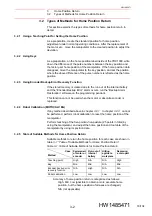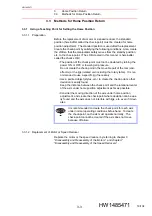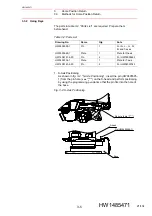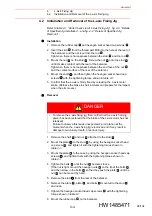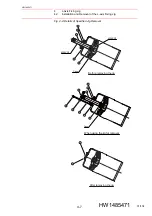
3
Home Position Return
3.3
Methods for Home Position Return
3-3
HW1485471
HW1485471
3.3
Methods for Home Position Return
3.3.1 Using a Teaching Point for Setting the Home Position
3.3.1.1 Preparation
Before the replacement of a motor or a speed reducer, the standard
position (hereinafter called the check-point) must be created for home
position adjustment. The standard position is used after the replacement.
Create the check-point by satisfying the following conditions. Also, create
the JOB so that the manipulator safely moves from the standby position,
etc. to the check-point. (The JOB created in this manner is hereinafter
called the check-JOB.)
• The position of the check-point must not be deviated by turning the
power ON or OFF, or lowering air pressure.
Do not create the check-point in the movable part of the tool (end-
effector) or the jigs (related unit including the rotary table). It is rec-
ommended to use a specific jig if necessary.
• Use a pointed object (stylus, etc.) to create the check-point so that
deviation is easily found.
Keep the distance between the check-point and the rotational center
of the axis under home position adjustment as far as possible.
• Consider the moving direction of the axis under home position
adjustment, and create the check-point where deviation can be eas-
ily found and the axis does not interfere with jigs, etc. even if it devi-
ates.
3.3.1.2 Replacement of Motor or Speed Reducer
Replace the motor or the speed reducer by referring to
“Disassembly and Reassembly of the Motors”
and
“Disassembly and Reassembly of the Speed Reducers”
.
NOTE
It is recommended to create the check-point for each axis
under normal operating conditions beforehand. To create
the check-point, each axis must operate normally. The
check-point cannot be created if the axis does not move
because of failure.
19/134














